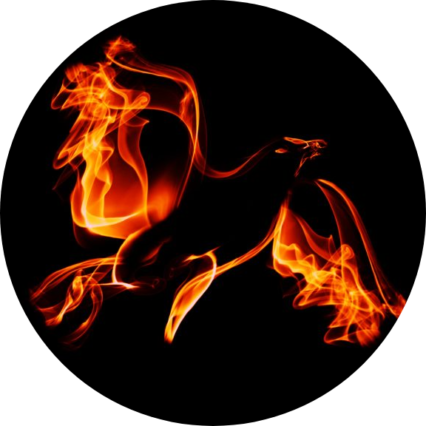Invoking the Mystical Phoenix
Pexels/Leon Contreras
The phoenix appears throughout the world as a symbol of rebirth and resilience. How can you invoke the power of the mystical phoenix in your daily life?
Imagine a fiery red, elegant, feather-winged beast rising from the ashes. This, the phoenix, is a familiar image for many of us. I can recall the very first time I encountered its majesty while watching Harry Potter and the Chamber of Secrets as a child.
I remember the moment precisely: Fawkes the phoenix—Hogwarts’ headmaster Albus Dumbledore’s animal companion—had just combusted into flames and been reduced to a pile of ash. Harry looked to his headmaster to apologize, thinking it was something he had done wrong that caused the fiery mess. Dumbledore quickly tells Harry that it is all right, that Fawkes is a phoenix. He explains, “Phoenixes burst into flame when it is time for them to die and are reborn from the ashes.” There was something so sad, yet so beautiful, about that scene, that it resonated deeply with me.
This concept of rebirth into brilliance is an intriguing one, one that some may find just as fantastical and imaginary as much of the rest of the Harry Potter universe. And while it has found itself deeply rooted in pop culture of today, the phoenix is an old creature with origins from across the globe.
The Global Origins of the Phoenix
The phoenix gets its name from the Greek word Φοίνιξ (Foínix). In ancient Greek lore, the phoenix is an immortal firebird with the ability to regenerate from its ashes. It is also associated with the sun. However, the phoenix first appeared in Egyptian mythology, when it was referred to by the name Bennu. Bennu is a mythological bird both feared and revered, said to be responsible for the flooding of the Nile and other acts of creation. The Egyptian firebird is also associated with the sun god Ra, the most venerated within his pantheon.
Cross-culturally, similar firebirds have known by many different names throughout history: in Chinese, fenghuang; in the Hindu faith appearing as Gandaberunda or Berunda; and in Persian mythology and literature as the simurgh.
Across the Atlantic, Native American myth points to the thunderbird as the phoenix’s counterpart. The thunderbird is a fierce and highly respected entity, which can summon storms and produce thunder with the flap of its wings.
In all of these instances, the phoenix holds a position as an indestructible entity, a symbol of strength and freedom, resilience, and rebirth.
But the phoenix is not limited to polytheistic belief systems.
In Christianity, Jesus Christ’s resurrection can be a parallel theme to that of the phoenix. In his book A Dictionary of Biblical Tradition in English Literature, David Lyle Jeffrey explains, “early Christian writers construed the phoenix as a symbol not only of resurrection in general but also of Christ himself and his resurrection in particular.”
Ash Wednesday is celebrated as a reminder for Christians of human mortality. This holy day marks the first day of the Lenten season. On this day, some Christians receive ash on their forehead; “Remember that you are dust, and to dust you shall return.” This practice is reminiscent of the phoenix’s ashen cycles of life and death.
Scholars have disputed a reference to the phoenix in Hebrew Scriptures. Job 29:18, JPS Tanakh 1917 English translation, “Then I said: 'I shall die with my nest, And I shall multiply my days as the phoenix.’” In this instance, the word chol is being interpreted as phoenix, rather than “sand” as it often is.
In her article “The Phoenix in Rabbinic Literature,” professor M. R. Niehoff of the Hebrew University of Jerusalem explains, “rabbis were familiar with the details of the Hellenistic phoenix myths, and not only adapted the story to their own values but even enhanced its mythological dimension.” She explains that rabbis have “reactivated” the myth of the phoenix for their own purposes within their spiritual practices.
Much like the mythological bird itself, the meanings which humanity draws from the phoenix are constantly being rebirthed, reimagined, and reframed for new situations.
The Stories We Tell
As I mentioned, Harry Potter is to credit for introducing me to the phoenix and ultimately to my love of magic and myth. But the phoenix appears in books, movies, and television on a regular basis.
In the magical sensory-stimulating shadow play, Feathers of Fire: a Persian Epic by Hamid Rahmanian, a simurgh appears among a number of other shadowcast characters. The play utilizes Persian visual and artistic traditions to tell the legend of Zaul aand Rudabeh from the Shahnameh, an epic medieval poem. The play received the 2019 UNIMA-USA Award for Excellence in Live Performance and Design.
In 2020 we saw the phoenix arise (from the ashes) once more in Disney’s live-action remake of Mulan. In the film it serves as a replacement for the animated film’s character Mushu, an emissary for Mulan’s ancestors. This culminates in a breathtaking moment in which Mulan’s form is framed by the wings of the phoenix, making it appear that she possesses fiery wings herself in a moment of power and triumph.
The phoenix itself, or fenghuang, is a symbol of feminine power and royalty in Chinese culture, often paired with the dragon as a masculine counterpart. Say what you will about the film—and there’s much to be said cinematically and culturally—but that moment is certainly awe-inspiring. In retrospect, the replacement of Mushu (a dragon) with the feminine symbol of the phoenix makes sense in demonstrating Mulan as the powerful heroine she is.
As a woman, I embrace the feminine power of the phoenix.
Carrying the Phoenix
Many inspired by the myth of the phoenix choose to carry it with them as a symbol of freedom and strength, rebirth, and resilience. More personal significance can also be applied to the phoenix, which varies from person to person. We have seen this personal and artistic liberty demonstrated through the many iterations of the firebird myth throughout history.
Some choose to adorn their bodies with the imagery of the phoenix through jewelry and clothing inspired by the firebird. As Western tattoo taboo has gradually lifted over the years, many have flocked—pun intended—to get the fire-bird's imagery permanently inked into their skin.
A Meditation for Renewal
Awaken your phoenix spirit through meditation. This meditative practice can be grounded in rebirth and renewal. You may come out of this meditation feeling rejuvenated and empowered by the resilient energies of the phoenix reborn.
Many phoenix-themed meditations can be found online, including written instructional and guided audio meditations, many of which are available for free on YouTube. You may also choose to create your own meditation, allowing the power of the phoenix to guide you. Check out InsightTimer.com for a Rising of the Phoenix “Rebirth”
guided meditation.
To engage with the phoenix in your yoga practice, try out the Flying Phoenix Pose, which builds on Pigeon Pose and rises into balancing on one knee. This will be more comfortable with a pad for under the knee, such as a folded mat or a towel.
A Ritual to Cleanse and Let Go
Fire destroys, but it also cleanses. The phoenix teaches us this. This ritual is meant to help release painful or negative energies, emotions, and memories, and release them. Start by lighting a cleansing fire in a safe environment, this might be a fire-safe bowl or pot, fireplace, or outdoor fire pit.
Next take a piece of paper and write down what you’d like to release. Using a nice parchment and your favorite pen could be an added personal touch, but any kind of paper and writing utensil will do. Fold the paper before burning it. If you wish, take the time to fold it into the shape of a phoenix using origami technique (beginner’s instructions can be found on origami-tutorial.com).
Now is time to begin burning. Carefully place your paper into the fire and watch as it catches and slowly turns to ash. From the ashes, let rise forth a new beginning. Move forward.
A Ritual for Mourning and Release
Just as the phoenix symbolizes rebirth, it also symbolizes the cycle which humans face daily: death. Just as we come from the Earth, so too do we return. We face death daily. This can be a painful thing to process for many of us, but there are prayers and rituals we often use in order to alleviate or process that pain.
Upon publish date of this article, the COVID-19 pandemic continues to circulate, ending the lives of so many too soon. Due to social distancing and other safety measures, funerals and traditional mourning practices have become harder to arrange and many have had to adopt new practices in order to cope with loss.
Floating paper lanterns are one way that the phoenix can be invoked in a ritual for mourning and release. Like the phoenix, your lantern will rise into the skies in bright fiery light. This practice is not only incredibly beautiful but done outside—ideal for socially distanced gatherings.
As you light your lantern and send it off into the sky: say a prayer, read a passage from a book, or sing a song for your loved one.
Be sure to leave nature as you found it following your ceremony: seek out biodegradable lanterns for your ceremony, and clean up any matches or tools used to light the lanterns.
Cooking With the Phoenix and Dragon
In both traditional and American Chinese food, the phoenix and dragon have a symbolic presence. In Chinese dishes, the phoenix represents the presence of chicken, turkey, or other bird. Likewise, the dragon represents fish, snake, or other seafood in a dish. This is because of the resemblance the meats hold to these creatures. Birds, for obvious reasons, resemble the phoenix, while scaled creatures like fish or snakes resemble the dragon.
Next time you reach for the takeout menu of your favorite local Chinese restaurant, notice how these words are used. If you see “Dragon and Phoenix” don’t be surprised if you get a helping of chicken and shrimp in your dish.
Infuse the power of the phoenix into your cooking by preparing chicken, turkey, or even squab. If you’re feeling daring, add a bit of spice for a fiery kick only a phoenix could provide.
Continue reading about the mystical phoenix:



